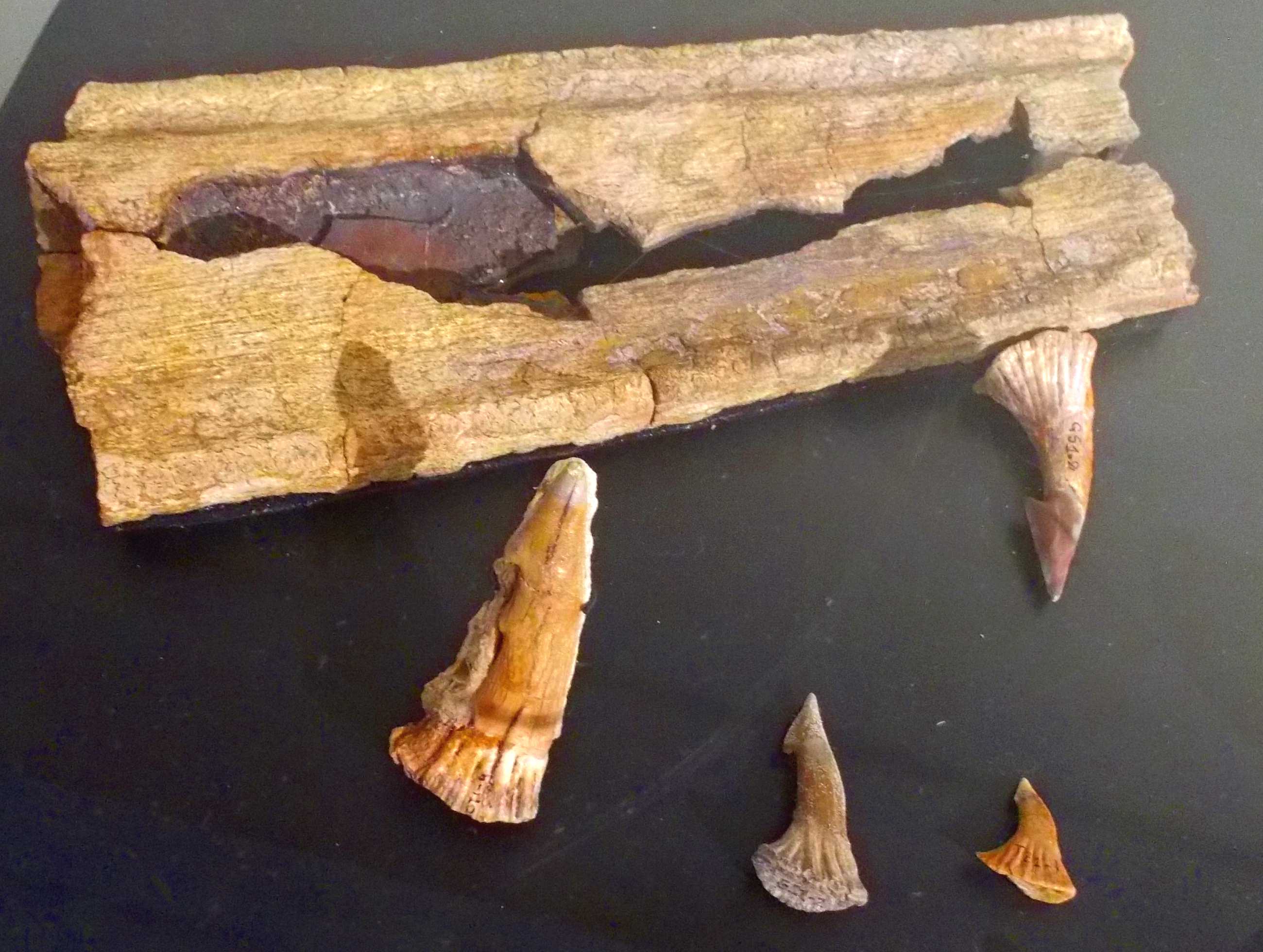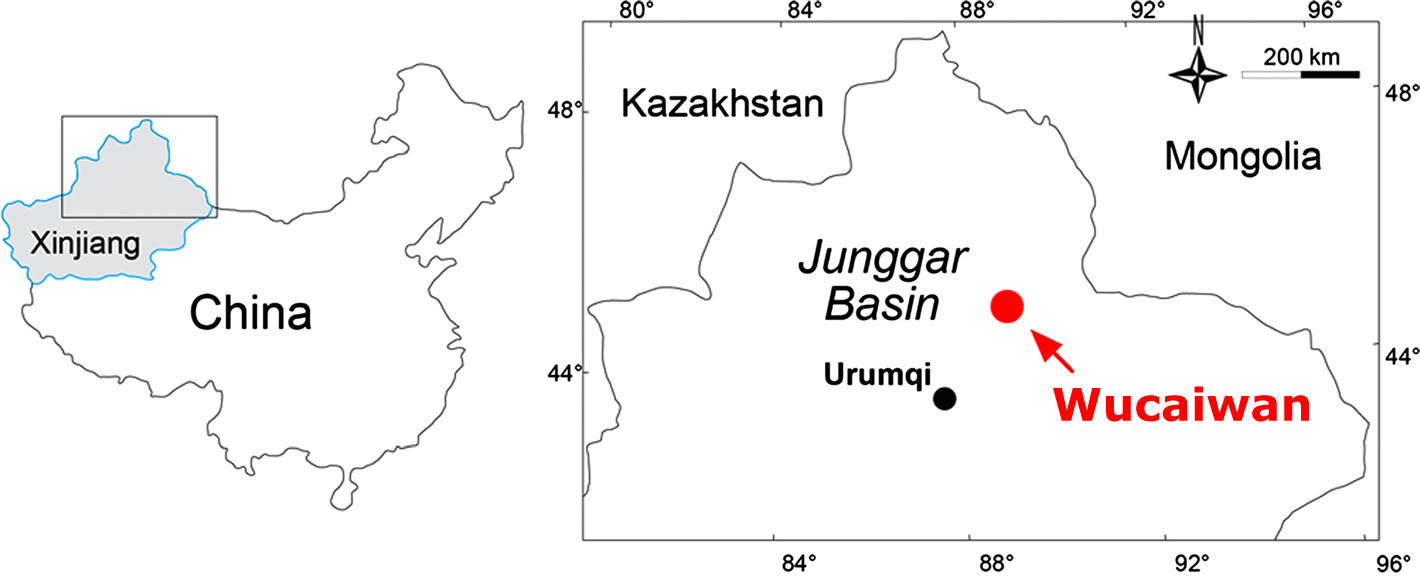|
Deltadromeus
''Deltadromeus'' (meaning "delta runner") is a genus of theropod dinosaur from Northern Africa. It had long, unusually slender hind limbs for its size, suggesting that it was a swift runner. The skull is not known. One fossil specimen of a single species (''D. agilis'', or "agile delta runner") has been described, found in the Kem Kem Beds, which date to the mid-Cretaceous Period (mid- Cenomanian age), about 95 million years ago. It may be a junior synonym of the contemporary '' Bahariasaurus''.Holtz, Thomas R. Jr. (2008) ''Dinosaurs: The Most Complete, Up-to-Date Encyclopedia for Dinosaur Lovers of All Ages'Supplementary Information/ref> The classification of ''Deltadromeus'' has been in flux since its original description. In 2016, a South American theropod known as '' Gualicho shinyae'' was found to possess many similarities with ''Deltadromeus''. Depending on the phylogenetic position of ''Gualicho'', ''Deltadromeus'' may have been a neovenatorid carnosaur, a tyrannosauro ... [...More Info...] [...Related Items...] OR: [Wikipedia] [Google] [Baidu] |
Noasauridae
Noasauridae is an extinct family of theropod dinosaurs belonging to the group Ceratosauria. They were closely related to the short-armed abelisaurids, although most noasaurids had much more traditional body types generally similar to other theropods. Their heads, on the other hand, had unusual adaptations depending on the subfamily. 'Traditional' noasaurids, sometimes grouped in the subfamily Noasaurinae, had sharp teeth which splayed outwards from a downturned lower jaw. The most complete and well-known example of these kinds of noasaurids was '' Masiakasaurus knopfleri'' from Madagascar. Another group, Elaphrosaurinae, has also been placed within Noasauridae by some studies. Elaphrosaurines developed toothless jaws and herbivorous diets, at least as adults. The most complete and well known elaphrosaurine was '' Limusaurus inextricabilis''. At least some noasaurids had pneumatised cervical vertebrae.Arthur Souza Brum, Elaine Batista Machado, Diogenes de Almeida Campos & Al ... [...More Info...] [...Related Items...] OR: [Wikipedia] [Google] [Baidu] |
Bahariasaurus
''Bahariasaurus'' (meaning "Bahariya lizard") is an enigmatic genus of large theropod dinosaur. ''Bahariasaurus'' is known to have included at least 1 species, ''Bahariasaurus ingens'', which was found in North African rock layers dating to the Cenomanian and Turonian ages of the Late Cretaceous. The only fossils confidently assigned to ''Bahariasaurus'' were found in the Bahariya Formation of the Bahariya (Arabic: الواحة البحرية meaning the "northern oasis") oasis in Egypt by Ernst Stromer but were destroyed during a World War II bombing raid with the same raid taking out the holotype of ''Spinosaurus'' and ''Aegyptosaurus'' among other animals found in the Bahariya Formation. While there have been more fossils assigned to the genus such as some from the Farak Formation of Niger, these remains are referred to with much less certainty. ''Bahariasaurus'' is, by most estimations, one of the largest theropods, approaching the size of other large bodied theropods such a ... [...More Info...] [...Related Items...] OR: [Wikipedia] [Google] [Baidu] |
Megaraptora
Megaraptora is a clade of carnivorous tetanuran theropod dinosaurs with controversial relations to other theropods. Its derived members, the Megaraptoridae are noted for their elongated hand claws and proportionally large arms, which are usually reduced in size in other large theropods. Megaraptorans are incompletely known, and no complete megaraptoran skeleton has been found. However, they still possessed a number of unique features. Their forelimbs were large and strongly built, and the ulna bone had a unique shape in members of the family Megaraptoridae, a subset of megaraptorans which excludes ''Fukuiraptor'' and ''Phuwiangvenator''. The first two fingers were elongated, with massive curved claws, while the third finger was small. Megaraptoran skull material is very incomplete, but a juvenile ''Megaraptor'' described in 2014 preserved a portion of the snout, which was long and slender. Leg bones referred to megaraptorans were also quite slender and similar to those of coeluro ... [...More Info...] [...Related Items...] OR: [Wikipedia] [Google] [Baidu] |
Ceratosaur
Ceratosaurs are members of the clade Ceratosauria, a group of dinosaurs defined as all theropods sharing a more recent common ancestor with ''Ceratosaurus'' than with birds. The oldest known ceratosaur, '' Saltriovenator'', dates to the earliest part of the Jurassic, around 199 million years ago. According to the majority of the latest research, Ceratosauria includes three major clades: Ceratosauridae, Noasauridae, and Abelisauridae, found primarily (though not exclusively) in the Southern Hemisphere. Originally, Ceratosauria included the above dinosaurs plus the Late Triassic to Early Jurassic Coelophysoidea and Dilophosauridae, implying a much earlier divergence of ceratosaurs from other theropods. However, most recent studies have shown that coelophysoids and dilophosaurids do not form a natural group with other ceratosaurs, and are excluded from this group. Ceratosauria derives its names from the type species, ''Ceratosaurus nasicornis'', described by O.C. Marsh in 1884. ... [...More Info...] [...Related Items...] OR: [Wikipedia] [Google] [Baidu] |
Neovenatoridae
Neovenatoridae is a proposed clade of carcharodontosaurian dinosaurs uniting some primitive members of the group such as ''Neovenator'' with the Megaraptora, a group of theropods with controversial affinities. Other studies recover megaraptorans as basal coelurosaurs unrelated to carcharodontosaurs. Other theropods with uncertain affinities such as ''Gualicho'', '' Chilantaisaurus'' and ''Deltadromeus'' are also sometimes included. Classification Phylogenetic studies conducted by Benson, Carrano and Brusatte (2010) and Carrano, Benson and Sampson (2012) recovered the group Megaraptora as members of the Neovenatoridae. This would make neovenatorids the latest-surviving allosauroids; at least one megaraptoran, '' Orkoraptor'', lived near the end of the Mesozoic era, dating to the early Maastrichtian stage of the latest Cretaceous period, about 70 million years ago. On the other hand, Novas ''et al.'' (2012), while confirming that ''Neovenator'' was closely related to carcharodont ... [...More Info...] [...Related Items...] OR: [Wikipedia] [Google] [Baidu] |
Ceratosauria
Ceratosaurs are members of the clade Ceratosauria, a group of dinosaurs defined as all theropods sharing a more recent common ancestor with '' Ceratosaurus'' than with birds. The oldest known ceratosaur, '' Saltriovenator'', dates to the earliest part of the Jurassic, around 199 million years ago. According to the majority of the latest research, Ceratosauria includes three major clades: Ceratosauridae, Noasauridae, and Abelisauridae, found primarily (though not exclusively) in the Southern Hemisphere. Originally, Ceratosauria included the above dinosaurs plus the Late Triassic to Early Jurassic Coelophysoidea and Dilophosauridae, implying a much earlier divergence of ceratosaurs from other theropods. However, most recent studies have shown that coelophysoids and dilophosaurids do not form a natural group with other ceratosaurs, and are excluded from this group. Ceratosauria derives its names from the type species, '' Ceratosaurus nasicornis'', described by O.C. Marsh in 1 ... [...More Info...] [...Related Items...] OR: [Wikipedia] [Google] [Baidu] |
Kem Kem Beds
The Kem Kem Group (commonly known as the Kem Kem beds) is a geological group in the Kem Kem region of eastern Morocco, whose strata date back to the Cenomanian stage of the Late Cretaceous. Its strata are subdivided into two geological formations, the lower Gara Sbaa Formation and the upper Douira Formation. It is exposed on an escarpment along the Algeria–Morocco border. The unit unconformably overlies Paleozoic marine units of Cambrian, Silurian and Devonian age, and is itself capped by limestone platform rock of Cenomanian-Turonian age. It primarily consists of deltaic deposits. The lower Gara Sbaa Formation primarily consists of fine and medium grained sandstone, while the Douira Formation consists of fining-upwards, coarse-to-fine grained sandstones intercalated with siltstones, variegated mudstones, and occasional thin gypsiferous evaporites. Dinosaur remains are among the fossils that have been recovered from the group.Weishampel, David B; ''et al.'' (2004). "D ... [...More Info...] [...Related Items...] OR: [Wikipedia] [Google] [Baidu] |
Limusaurus
''Limusaurus'' is a genus of theropod dinosaur that lived in what is now China during the Late Jurassic, around 161 to 157 million years ago. The type and only species ''Limusaurus inextricabilis'' was described in 2009 from specimens found in the Upper Shishugou Formation in the Junggar Basin of China. The genus name consists of the Latin words for "mud" and "lizard", and the species name means "impossible to extricate", both referring to these specimens possibly dying after being mired. ''Limusaurus'' was a small, slender animal, about in length and in weight, which had a long neck and legs but very small forelimbs (with reduced first and fourth fingers). It underwent a drastic morphological transformation as it aged: while juveniles were toothed, these teeth were completely lost and replaced by a beak with age. Several of these features were convergently similar to the later ornithomimid theropods as well as the earlier non-dinosaurian shuvosaurids. ''Limusauru ... [...More Info...] [...Related Items...] OR: [Wikipedia] [Google] [Baidu] |
Gualicho
''Gualicho'' (named in reference to the gualichu) is a genus of theropod dinosaur. The type species is ''Gualicho shinyae''. It lived in what is now northern Patagonia, on what was then a South American island continent split off from the supercontinent Gondwana. The fossils were found in the Huincul Formation, dating to the late Cenomanian-early Turonian age of the upper Cretaceous Period, around 91 million years ago. Discovery On 13 February 2007, Akiko Shinya, preparator of the Field Museum of Natural History, east of the Ezequiel Ramos Mexía Reservoir at the Rancho Violante, discovered the skeleton of a theropod new to science. In 2016, the specimen was named and described by Sebastián Apesteguía, Nathan D. Smith, Rubén Juárez Valieri and Peter J. Makovicky. The generic name is derived from the '' gualichu'', a demon of local folklore. The specific name honours Shinya as the animal's discoverer. The holotype, MPCN PV 0001, consists of a partial skeleton lacking th ... [...More Info...] [...Related Items...] OR: [Wikipedia] [Google] [Baidu] |




.jpg)


